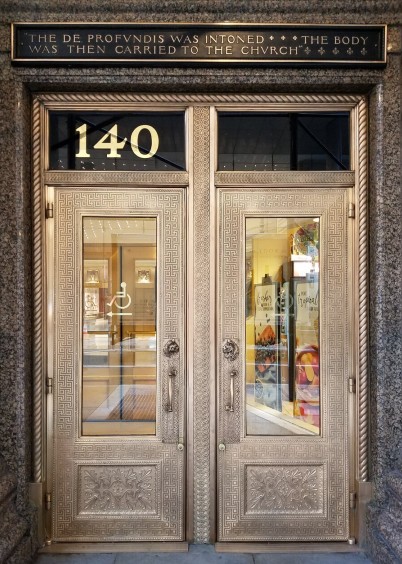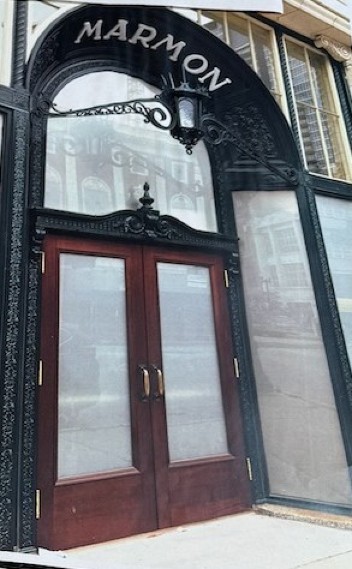By Sann Knipple, Class of 2023
MTH Industries has been building Chicago since 1886. A combination of four historically significant companies, Tyler & Hippach Glass Company (1886), Illinois Bronze Works (1923), Midwest Glass Company (1930), and Midwest Iron Works (1938), MTH creates and preserves Chicago’s architectural heritage by installing and renovating windows and structural and ornamental metal elements.
Docents are familiar with MTH’s work even if we do not know their name; MTH installed the 10 ft. x 40 ft. laminated glass units at Apple Michigan Avenue, the 1,500 pound cantilevered glass panels of the The Ledge at Willis Tower, and erected and polished Cloud Gate (“The Bean”).

Lou Nutini started his career with Illinois Bronze Works, where his father also worked, and has been involved in the construction and renovation of many iconic Chicago buildings. He has even restored ornamental metal that his father’s generation removed during what we now regard as ill-conceived renovations in the 1950s and 60s. The photo below on the left shows the original entrance to the Monroe Building at 104 S. Michigan Avenue. The elaborate ornamental cast iron arch piece above the door was thrown away; Lou helped recreate it decades later, after J&J ARNACO purchased the building and committed to restoring it to its original grandeur.
Lou credits a very talented artisan working with a foundry in Topeka, Kansas, for painstakingly creating a new mold to cast a replacement piece with only old photographs for reference. The photo above on the right shows the new casting, correct down to the “M” detail in the center of the arch. And the photo below shows it installed.

That same artisan’s talents were also key to the restoration of 333 N. Michigan Avenue. The original ornate entranceway had been dramatically altered (see photo below on the left), and MTH was brought in to restore it. This time MTH had access to original drawings of the building as well as photographs (below center and right), but the artisan still had to recreate the molds for all of the ornamentation and lamps.
While pondering what the horseshoe-like wreaths on either side of the door in the photo might look like, Lou said the artist noticed very similar ornaments on the Michigan Avenue Bridge, which led her to create the replica shown in the top left photo below, a very heavy artifact in MTH’s offices. Other artifacts include details from the renovation of the plaza between the two Wrigley Building towers (top right below), door handles in the shape of the seal of Illinois from the Statehouse (bottom left below), and a nickel silver bronze piece that you can see on the elevator doors in the lobby of 2 N. Riverside (bottom right below).
MTH Industries is proud to have been awarded the Divine Detail Award by AIA Chicago for the restoration of the Marquette Buildings doors to achieve ADA compliance. Lou said the original doors were actually a wood core with a thin layer of bronze cladding. The new doors (photo below left) are solid bronze replicas with a new middle mullion as part of one of the door leaves that allows enough space for a wheelchair to pass through. And the doors are adorned with the original panther/lion pulls (there’s some debate on the actual animal depicted) that were designed by Edward Kemeys, who also designed the lions that flank the entrance of the Art Institute.
When the Palmer House installed interior fire escapes and removed the unsightly external fire escapes from the building on the State Street side, MTH replicated the large windows on that side of the building to fill the gap (see drawing in photo above right with fire escapes on the left and window design on the right plus a photo of the new window at the bottom). MTH also restored the glorious Tiffany Peacock Doors in the hotel. And MTH is behind the incredible reconstruction of the historic main entrance and rotunda in the London House. Lou chuckled about the showers of gold leaf while it was being applied to the ceilings there.
An animated storyteller, Lou particularly lit up when he showed me a very special book, Anaconda Architectural Extruded Shapes published by the American Brass Company. When Lou needed to replicate an extruded brass ornament, he remembered this book, a gift to him from an architect friend, long ago. Lou was able to match the needed piece to a pattern in the book, (photo below) which made it much easier to order the fabrication of the new pieces.

One thing I noted during our conversation was how many of the foundries and manufacturers that Lou used to work with on these projects have closed. Lou said they now work with more foreign suppliers than they used to, but there is a local foundry, Trio, in Montgomery, Illinois. MTH has worked with them on projects like the Marquette Building’s ADA-compliant doors, the base supporting the “Gentlemen” sculpture outside of the AMA Plaza, and recreating the intricate lantern that was missing from the Marmon Building’s entrance in the Motor Row District of the South Loop (see series of photos below, original entrance at left, entrance in disrepair at center, restored entrance at right, lantern in Trio Foundry at bottom). I’ll have to see if Lou can wrangle us a docent enrichment visit to Trio!


CLICK HERE for more stories on The Bridge.
















Thanks San for fascinating article and pictures. Sounds like it was fun interviewing Lou.
The Anonymous was me. Sorry forgot to add my name.
Thank you, Russell! He was a fountain of information and experience…he’d make a fantastic docent!
Wonderful article, Sann. I learned a ton, and the photos were especially helpful.
Loved this article and the before and after photos. We have so little chance to really go behind the scenes. Thank so much! Bobbi
What an interesting inside look at these beautiful restorations. My husband worked in the Monroe Building and I really appreciated the beautiful work that was done. So nice to know the story behind it!
Thanks, Marcia
Great article, nice pictures, great information. Thanks